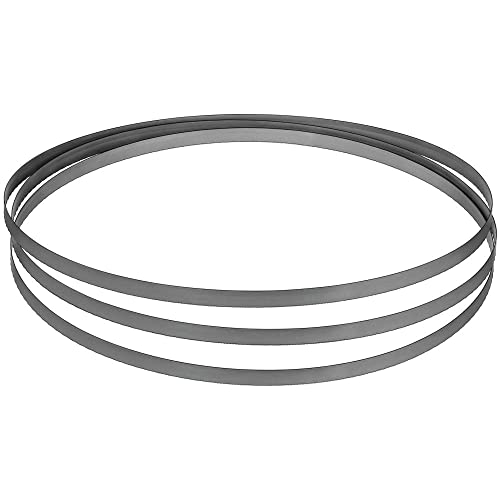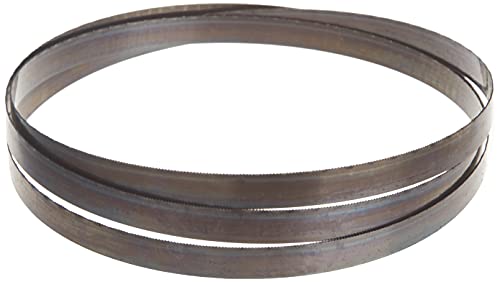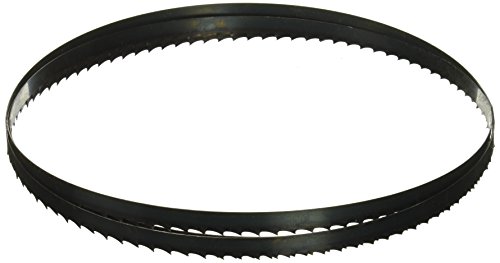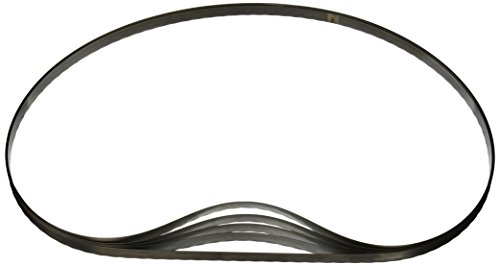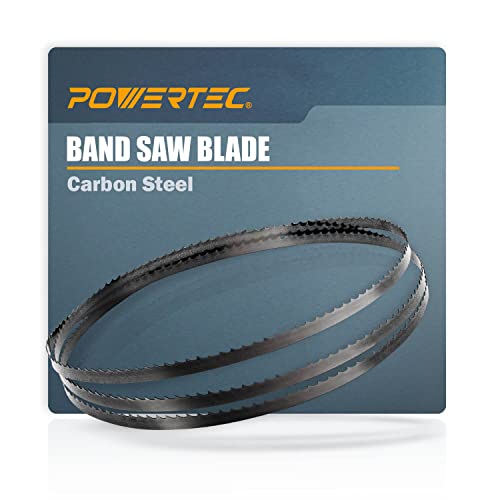The Best Band Saw Blades
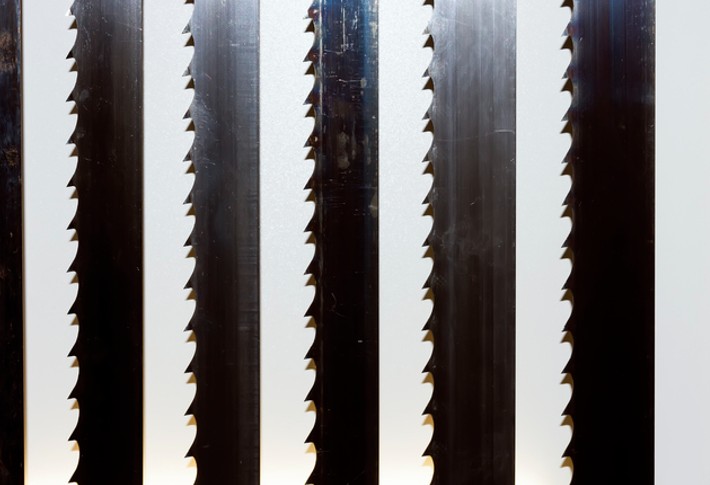
Are you looking to get the most out of your woodworking projects? If you want to make precision cuts without fail, then you’ll need to invest in a good quality band saw blade. Band saw blades are specifically designed to cut through a variety of materials, including wood, metal, and plastic. But how do you choose the right blade for your needs?
This guide is a comprehensive look into all things band saw blades. By understanding your options and learning about what you should look for as you search for a band saw blade, you’ll be able to choose the most suitable blade for your projects. We’ll discuss the different features and review some of the top-rated blades on the market in 2023 to help you make the most informed decision.
- Best Overall: DEWALT Band Saw Blade Shop Now ➔
- Clean Cuts: BOSCH Band Saw Blade Shop Now ➔
- Minimal Vibration: Olson Band Saw Blade Shop Now ➔
- Best for Metal: LENOX Band Saw Blade Shop Now ➔
- Most Versatile: POWERTEC Band Saw Blade Shop Now ➔
- Buying Guide: Band Saw Blades
- People Also Asked
- What are the different types of band saw blades?
- What is the best type of band saw blade for cutting wood?
- How do I know what size of band saw blade I need?
- What tooth pattern should I use for a particular cutting job?
- How do I install a band saw blade?
- How often should I replace my band saw blades?
- Are there any safety tips to keep in mind when using band saw blades?
- Can I sharpen a dull band saw blade?
- What is the difference between a regular blade and a carbide-tipped blade?
Comparing the Top Band Saw Blades of 2023
Best Overall
The DEWALT Portable Band Saw blade is an incredible choice for a band saw blade. Not only is the blade crafted from Matrix II high-speed steel, but the edge of the saw is designed to resist heat and wear and tear, making it ideal for rough and tough cuts.
The eight percent cobalt content of the blade also enhances the tool’s durability as well. Additionally, the alloy steel backer of this saw provides fatigue resistance, which helps to ensure that the tool can complete more difficult tasks with ease, placing this band saw blade at the top of our list!
Pros
- Great value for the price
- Low likelihood of blade breakage
- Cuts very easily
- Highly durable and reliable
Cons
- Not compatible with all band saws
Clean Cuts
The BOSCH Metal Band Saw Blade offers superior performance thanks to its premium-grade steel construction. The band saw blade can resist heat build-up, which ultimately extends the lifespan of the blade. Additionally, the optimized tooth geometry provides outstanding cutting performance.
This band saw blade option is most suitable for HVAC contractors, plumbers, and electricians. The tool can assist professionals with a wide array of projects, especially because the band saw blade is versatile and capable of cutting a variety of materials with precision. The blade holds up well with even the most difficult of materials, so thickness and hardness shouldn’t be a problem when you’re operating a band saw fitted with this blade.
Pros
- Makes accurate, reliable cuts
- Great price point
- Stays sharp for long periods
Cons
- Might be too advanced for beginners
Minimal Vibration
The Olson Saw Band Saw Blade is favorable because of its simple installation process. The band saw blade is easy to handle, making it great for just about any project. Whether you’re cutting hardwood, softwood, plastic, mild steel, or non-ferrous metal, this saw blade can help you achieve superior results every single time. The band saw blade is designed specifically for vertical, stationary, and floor-standing two-wheel band saws.
It’s strong and sturdy enough to handle tough, lengthy projects as well. Not only is this band saw blade heavy-duty and durable but it is also considered commercial-grade. A great tool for professionals and beginners alike, the band saw blade only weighs 6.4 ounces, meaning it should be light enough for most people to manage and maneuver. The lightweight nature of this band saw blade should minimize the vibrations you feel as you use the tool as well.
Pros
- Cuts accurately and smoothly
- Lessens the need for sanding after cutting
- Lasts a long time with proper maintenance
- Doesn’t cause blade drift when cutting
Cons
- May not work with other saw brands
Best for Metal
The LENOX Tools Portable Band Saw Blade is made from high-speed steel teeth. As such, this type of blade can provide a powerful and long-lasting approach to cutting, especially when used with metal materials. Additionally, each blade is shatter-resistant thanks to the bi-metal construction. The Tuff Tooth design reinforces each tooth, resulting in added durability and longer blade lifespans.
Whether you’re a professional contractor by trade or a DIYer as a hobby, you’ll appreciate the superior strength and performance that these blades offer. These band saw blades can bend without breaking while also delivering exceptional longevity. With 18 teeth per inch (TPI) on each blade, these band saw blades can easily cut through even the toughest materials with ease.
Pros
- Does not dull easily
- Thin kerf as advertised
- Great value for the price
- Easy to cut various materials
Cons
- Requires slower speed than other blades
Most Versatile
The POWERTEC Band Saw Blade is made of high-grade carbon steel. As a heat-resistant tool, the band saw blade’s optimal geometric tooth arrangement results in seamless outcomes at high-performance speeds. This flexible and carbon hard-edge blade works well with both hard and soft materials.
From wood and plastic to non-ferrous metals, this band saw blade is versatile and compatible with different types of material. It can also be paired with Sears, B&D, Ryobi, Delta, and Skil 9″ band saws. Its TPI count of 14 speaks to the regular teeth on the blade, and the tool offers impressive sharpness.
Pros
- Cuts along curves with ease
- Sharp, fine teeth
- Easy to fit into band saws
- Great price point
Cons
- Blades may become dull quickly
Buying Guide: Band Saw Blades
Whether you are woodworking, metalworking, or lumbering, a band saw is a woodshop staple. A band saw, however, is only as good as its blade. We’ve compiled the key features to consider when shopping for band saw blades to ensure you get the right fit for your saw.
Blade Width
You should consider the width of the materials you want to cut when deciding how wide you want your blade to be. Larger blades can handle thicker materials whereas narrower blades are better suited for situations where you’re working with thinner materials.
Blade Length
The length of the blade should be able to accommodate the depth of your cuts. When buying a new blade, measure the inside diameter of your band saw wheel and ensure that the blade can fit within that space.
Blade Thickness
The thickness of the blade will determine which materials you can cut as well as how much power you’ll need to cut the materials. Thinner blades require less power and they generally have fewer teeth than thicker blades, which often require more power, though they yield a smoother finish due to having more teeth.
Tooth Count
The tooth count of a band saw blade will determine how fine or how rough the cut will be because this detail relies on the number of teeth per inch (TPI). A higher TPI value will result in smoother edges whereas a lower TPI will create rougher edges. It’s best to experiment with different blades until you find one that produces your desired finish.
Set
Band saw blades come in various sets, known as staggered, raker, and hook sets. Each set will impact the performance of the blade differently, so consider the types of sets and select your preference based on the type of cuts that you need to make.
Construction Material
Band saw blades are typically made from either carbide-tipped or bimetal construction materials. Carbide-tipped blades tend to last longer and offer a smoother finish. On the other hand, bimetal blades are slightly more cost-effective, though they may not last as long as carbide-tipped blades.
Hook Angle
The hook angle is an important factor to think about when selecting a band saw blade. This is because the hook angle will affect how easily and quickly materials can be cut by the blade. A low hook angle results in a slower cutting speed while higher hook angles result in faster cutting speeds.
Kerf Size
The kerf size is determined by the thickness of the blade itself. It is important to think about because it can ensure that the cuts you make are successful and accurate. Choose a blade with a kerf size that is suitable for your material thickness as well as the size of your workpiece.
Compatibility With Saw Drive Wheels
Before purchasing a band saw blade, check to see that it will be compatible with your saw’s drive wheel. Additionally, verify that the drive wheel has enough power to turn the blade without stalling or slipping out of position while in use.
Tooth Shape
Band saw blades come in various tooth shapes, including skip tooth, variable pitch, and standard pitch teeth to name a few options. Different shapes yield different results, and the type of material being cut can impact the outcome as well, so keep this in mind as you search for the right band saw blade for your project.
Maximum Cutting Capacity
Determine the thickness of the material that you need to cut before you select a band saw blade to ensure that the blade has the proper cutting capacity. This information can be found on either the product packaging or via the manufacturer directly if not listed on-site at the purchase point.
Recommended Cutting Speed
Different materials require different cutting speeds. It all depends on the hardness level and structure type of the materials. This information is usually included on product packaging, though you can also contact manufacturers directly if the information is not listed on-site at the purchase point. Make sure you follow the guidelines on recommended cutting speeds when operating your band saw. Doing so will ensure the utmost safety and accuracy.
Heat Resistance Rating
When deciding which band saw blade to purchase, consider its heat resistance rating. Some blades produce higher levels of heat when in operation than others. The amount of heat that is produced often depends on the materials and the design details, which should be considered when making your decision.
Noise Level
The noise levels of band saw blades can vary depending on the cutting speed, so it’s important to check noise ratings before you make a purchase. This can help you avoid any noise pollution issues during use.
Price
The prices of blades will depend on a variety of factors. Start by determining which type of band saw blade you need, and then start comparing the prices across different brands of blades. You can also read customer reviews to gain insight into how different blade brands compare in terms of value and efficiency.
People Also Asked
What are the different types of band saw blades?
The different types of band saw blades include regular-tooth, skip-tooth, hook-tooth, variable-tooth, carbide-tipped, and diamond-grit.
What is the best type of band saw blade for cutting wood?
The best type of band saw blade for cutting wood is a hook-tooth blade with a high tooth count. This type of blade allows for faster cuts with less wood burning and fewer vibrations.
How do I know what size of band saw blade I need?
Measure the inside width and circumference of your saw’s wheel to determine the size of the blade that you’ll need. Additionally, consider the material that you will be cutting, as well as its thickness and hardness, to determine the proper blade width.
What tooth pattern should I use for a particular cutting job?
The exact tooth pattern will depend on the type of material you are cutting and your desired results. For instance, if you are cutting soft materials, like aluminum or brass, then you should use a skip-tooth pattern. For harder materials, like steel or hardwoods, opt for a regular-tooth pattern or a variable-tooth pattern instead so that you can make intricate cuts with ease.
How do I install a band saw blade?
First, make sure you remove any guards that cover the wheels or tensioning mechanisms on your saw. Next, add tension to the blade with either hand tools or hydraulic tensioners until the blade is taught across the wheels. Finally, lock the blade in place at both ends before testing it out with light cuts on scrap material.
How often should I replace my band saw blades?
The frequency at which you should replace your band saw blades depends largely on how often you use them. The hardness of the materials you are cutting will need to be considered as well. Generally speaking, you should replace them when they become dull, which is often about every few months or so if you are using your band saw blades regularly.
Are there any safety tips to keep in mind when using band saw blades?
Yes, there are several safety tips to keep in mind when using band saw blades. For starters, always wear eye protection and gloves when operating your saw. Make sure you aren’t wearing any loose clothing items that can get caught in the machinery. Also, never force the blade to cut through materials by pushing too hard on the blade. Last but not least, make sure your hands are not near any moving parts, and always unplug your saw when it is not in use.
Can I sharpen a dull band saw blade?
Yes, it is possible to sharpen dull band saw blades with either a bench grinder or a special sharpening tool designed specifically for this purpose. However, it is important to note that frequent sharpening can lead to reduced performance and shorter life spans of your blade.
What is the difference between a regular blade and a carbide-tipped blade?
A regular band saw blade typically has teeth that are shaped from high-speed steel (HSS). On the other hand, a carbide-tipped blade contains teeth made from more durable tungsten carbide material. This material makes carbide-tipped blades better suited for long-lasting durable cuts that you need to make when working with hard materials, like stainless steel or titanium alloys.
Article Contributors
The Woodsmith Review Team’s product reviews and in-depth guides are here to help you choose the best tools and gear to build great-looking projects confidently. Woodsmith is reader-supported: When you buy through links on our site, we may earn an affiliate commission. Large language models (like Artificial Intelligence) may have been used in the research and creation of the content.
Inquiries regarding specific articles or product testing should be sent to aimperiapt@gmail.com

